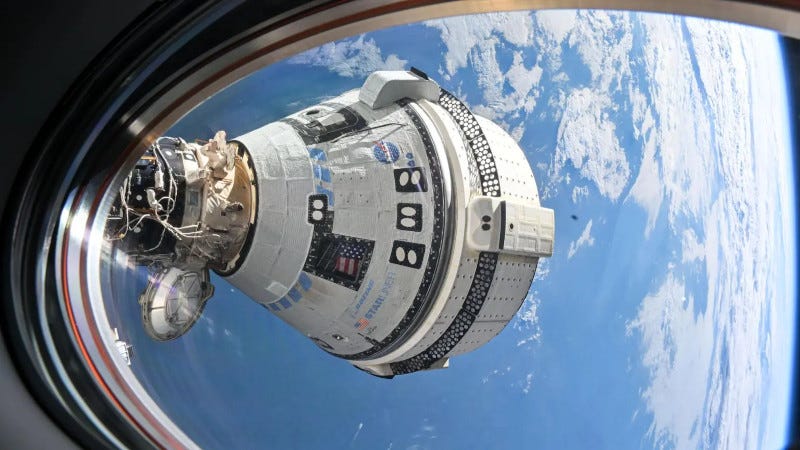The Starliner Saga Continues While Dream Chaser Preps for Launch
Top Stories from The Journal of Space Commerce for the Week Ending Aug 11
What was supposed to have been an eight-day test flight has turned into a two-month-plus stay aboard the International Space Station for Butch Wilmore and Suni Williams, and now NASA and Boeing are debating whether the astronauts will be able to return to Earth aboard Starliner, or remain on the ISS through February 2025.
During a media teleconference this week, NASA associate administrator for Space Operations Mission Directorate Ken Bowersox said that the agency is considering all its options for returning the astronauts back to Earth, including the option to either bring the crew home on the Starliner or to bring the crew home on another vehicle. "We could take either path, and reasonable people could pick either path," Bowersox said.
Steve Stich, manager of the Commercial Crew Program addressed the issue of an unmanned undocking of Starliner from the ISS, saying that "the flight software we have on board today are set up for a crewed undock" and there making a change to an uncrewed undocking is more complicated that just uploading new software. But Starliner undocked autonomously on the previous uncrewed flight test, so the capability is there.
Clearly, NASA is weighing all the options and has the safety of the astronauts as its primary concern.
-0-
Meanwhile, another option for commercial resupply missions is preparing for its first flight test to the ISS. Final testing and launch preparations for the Sierra Space Dream Chaser spaceplane and Shooting Star cargo module have begun at NASA’s Kennedy Space Center in Florida ahead of the company’s inaugural ISS resupply mission.
According to Sierra Space, the Dream Chaser transportation system, which includes cargo delivery and return capability on the world’s first commercial spaceplane – as well as delivery and disposal capability with the detachable and disposable Shooting Star cargo module – will add an entirely new dimension to NASA’s Commercial Resupply Services missions. The winged Dream Chaser lands on a runway and will be the first spacecraft to do so on a return mission from the space station since Space Shuttle Atlantis in July 2011.
As regular mission operations near reality, Sierra Space is also preparing for ground reprocessing operations of its reusable Dream Chaser spaceplane onsite in Florida to ensure efficient mission turnaround time, awarding a ground support contract to All Points Logistics.
-0-
As changes are weighed in the Crew-9 manifest should the SpaceX Dragon need to accommodate the Boeing Starliner crew's return to Earth, the personnel for the Crew-10 mission planned for February 2025 have been announced.
NASA astronauts Commander Anne McClain and Pilot Nichole Ayers, JAXA (Japan Aerospace Exploration Agency) astronaut Mission Specialist Takuya Onishi, and Roscosmos cosmonaut Mission Specialist Kirill Peskov will join astronauts at the orbiting laboratory no earlier than February 2025.
The flight is the 10th crew rotation with SpaceX to the station as part of NASA’s Commercial Crew Program. While aboard, the international crew will conduct scientific investigations and technology demonstrations to help prepare humans for future missions and benefit people on Earth.
-0-
The Europeans also made some commercial space news this week, starting with the ESA announcement of the development of a new subscription-based space mobility service called Omega. As part of ESA's Boost! Program, the work now begins after the initial contract signature in early June with a consortium consisting of Dawn Aerospace, UARX Space and Spherical Systems.
The Omega service would allow customers to buy and integrate ready-to-use smart propulsion systems that can be added to their satellite, backed by a ready-to-use, service. Customers would be able to call on the Omega service throughout a satellite’s lifetime, from launch, deployment, and collision avoidance to end-of-life deorbiting.
A subscription service would encompass everything a customer needs to fly in space, from arranging a launch opportunity to documentation support, the initial deployment of the satellite in space to planning and executing maneuvers throughout its lifetime.
-0-
And as ESA’s Hera mission for planetary defense completes its pre-launch testing, its target asteroids have come into focus as tiny worldlets of their own. A special issue of Nature Communications published last week presents studies of the Didymos asteroid and its Dimorphos moon, based on the roughly five and a half minutes of close-range footage returned by NASA’s DART spacecraft before it impacted the latter body – along with post-impact images from the Italian Space Agency’s LICIACube.
The images from DART’s DRACO camera plus LICIACube represent one of the most important data sources – until ESA’s Hera mission, which lifts off this October, reaches Didymos for its own close-up study in late 2026 to fill the remaining gaps in information, to provide a full picture of the DART impact.
Once it reaches the Didymos system in late 2026, Hera will perform a close-up survey of the post-impact Dimorphos while also acquiring data on Didymos. The spacecraft will also release a pair of shoebox-sized CubeSats for complementary observations, including the first radar survey within an asteroid.
https://www.exterrajsc.com









